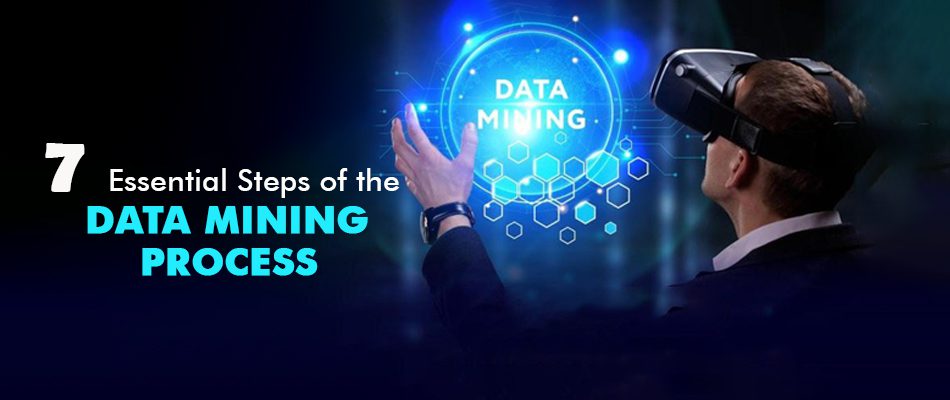The digital revolution is known to all. As an aftereffect, companies had to start collecting and managing humongous quantities of data. This was done with an intention of maintaining a competitive edge. Big data has turned up to be quite an important aspect of every business today. While most of them realise they, the uncertainty as to how to use it to their benefit is still prevalent.
The entire cumulation of business intelligence and analytics has evolved into a science. There are entire teams of data specialists, data engineers, data analysts, and others. These professionals aid businesses in sorting and aggregating data with the purpose of extracting insights. Since data miners are needed, the field is continuing to evolve and grow.
But do you know what data mining is and how does it work? With this blog, we will give you all the necessary information about data mining. Additionally, we will also discuss the 7 essential steps of the data mining process.
It is always best to begin with the primary steps. Thus, we are going to get started with what is meant by Data Mining.
What is Data Mining?
Data Mining is the process carried out uncover patterns as well as knowledge from humongous amounts of data. There are multiple data sources and include the web, data warehouses, databases, etc.
The Need for Data Mining for Businesses
Data Mining has become more prevalent due to the advent of Big Data. Big Data has all the imperative information needed by business in terms of different types and content. Since the data at hand is a lot, simple statistics will not work. Manual intervention is not enough.
This need is in turn fulfilled by the process of Data Mining. Relevant information can be extracted from raw data such as videos, photos, transactions, flat files, etc. The information is automatically processed to generate reports that will enable business to make amend and take actions.
The process of Data Mining is highly crucial for business. It aids them in making better decisions. This happens because patters and trends in data get discovered. The data is summarised and all the relevant information is extracted.
7 Essential Steps of the Data Mining Process
There is a lot of data that a company collects. To know which one is important and which is not, it can be pretty difficult. However, the Data Mining process makes it easy.
But Data Mining does not happen in a single flick of the wrist. It takes quite a lot of steps and here are the 7 essential steps to know about.
- Data Cleaning
The first step is all about cleaning the collected data. Teams get to cleaning the data so that it sits well with the industry standards. This step is super essential because incomplete or dirty data can lead to poor insights as well as system failures. Thus, costing the company more money and time.
All the unclear data is removed from the company’s acquired data. A lot of data pre-processing as well as cleaning methods are used. Which of these is used depends highly upon the resources of the business.
The binning method is often used for removing noisy data, resolving any inconsistencies, and identifying outliers.
- Data Integration
Data integration is referred to as the step wherein different sources and data sets are combined to performed analysis. Carried out by the data miners, it is one top most mining techniques out there. It is used for streamlining the entire process of extracting, transforming, and loading.
A lot of specialists conduct an additional layer of data cleaning during this stage. Thus, any inconsistencies that might have passed the first step are eliminated. Many Data Mining tools including Microsoft SQL ae used to integrate data.
- Data Reduction for Data Quality
This is the step where relevant information is extracted for pattern evaluation and data analysis. A small size of data is picked and its integrity is maintained during data reduction. Many strategies can be chosen from including numerosity reduction, data compression, or dimensionality reduction.
In numerosity reduction, the original quantity of the data is replaced with a smaller portion of data by the teams. In data compression, a compressed generalization is offered by the engineers for the collected data. In dimensionality reduction, the quantity of the attributes is reduced by the engineers in the analytics data.
- Data Transformation
In the step of data transformation, the data is transformed into an acceptable form by the engineers. This is done to ensure it aligns well with the mining goals. The preparation data is consolidated to optimize the data mining process. All of this leads to easily discerning the patterns.
This step includes data mapping as well as other data science techniques. The strategies encompass eliminating or smoothing the noise from the data. There are many other popular techniques as well. These include discretization, aggregation, and normalization.
- Data Mining
Data Mining is used to extract useful trends and then optimize the knowledge discovery for generating business intelligence. But this is only possible when an organization takes complete advantage of big data and accumulates the right type of information.
Intelligent patterns are applied by the engineers to the available data. This is done prior to extracting it. All the information is then represented as models. Modelling techniques such as classification or clustering are used to ensure accuracy.
- Pattern Evaluation
This is the step where working behind the scenes stops and insights are brought into the real world. Specialists point out any and all patterns that might aid in generating more business knowledge.
Models, real-time information, and historical data is used to find out more insights about sales, employees, and customers. Visualization data mining techniques are also used by teams to make the insights easier to understand.
- Representing Knowledge in Data Mining
For the final step, data analysts make use of multiple reports, data visualization, and various other mining tools. The information is shared across to others via these means. Prior to starting the Data Mining process, business leaders discussed the goal and objective. This helps the engineers understand what they need to look for.
Analysts share their findings with the aid of reports. Dashboards or any other business intelligence tool can be used to generate these reports. The insights are used by the owners to optimize decision making, eliminate waste, create powerful advertising campaigns, and generate new business.
Important Data Mining Models
There are a few important Data Mining models that you should know about. As a data analyst, you will be learning all of these. Let us begin to understand each of these a bit.
- CRISP-DM – Cross-Industry Standard Process for Data Mining
It is a reliable Data Mining model that include six phases. This cyclic process offers a structured approach to the entire process of Data Mining. While the six phases can be carried out in any order, sometimes the analyst has to backtrack.
Here are the six phases of CRISP-DM are as follows –
- Business understanding
- Data understanding
- Data preparation
- Modelling
- Evaluation
- Deployment
- SEMMA – Sample, Explore, Modify, Model, Assess
Another important Data Mining methodology, it was developed by the SAS Institute. SEMMA is an acronym for sample, explore, modify, model, assess.
SEMMA is responsible for making the application of visualization techniques, exploratory statistical techniques, create a model incorporating the variables, check its accuracy, and select & transform the important predicted variables. This methodology is powered by a strongly iterative cycle.
Steps in SEMMA are –
- Sample
- Explore
- Modify
- Model
- Assess
Where is Data Mining Applicable?
Data Mining is applicable across various areas including but not limited to
- Financial data analysis
- Science and engineering
- Recommender systems
- Retain and telecommunication industries
- Intrusion detection and prevention
Challenges Associated with Data Mining
While Data Mining is a leading process, there are still a few challenges associated with it. With this blog, we intend to give you a brief about these challenges too. However, these challenges are not pulling the methodology down. Still, it is best to know about the challenges to be called an expert in the field of Data Mining.
- Data Mining requires humongous data collection and databases. It is not always easy to find or manage them.
- Incorporation from heterogeneous databases can be called a pretty complex process.
- Data Mining is all about expertise and thus, the demand for domain experts is high. However, it is not always a piece of cake to find such experts. (This can be concluded as an opportunity for those who wish to make a career in this profile.)
- In order to incorporate the results procured from the Data Mining process, all the organizational level practices need to be altered. This can prove to be a costly and effort-inciting step.
Conclusion
There are challenges in all the aspects of everything we do. However, you can find the ray of light within that too and get trained and certified to become an expert. Get in touch with experts at Grras Solutions to know more about this field.






